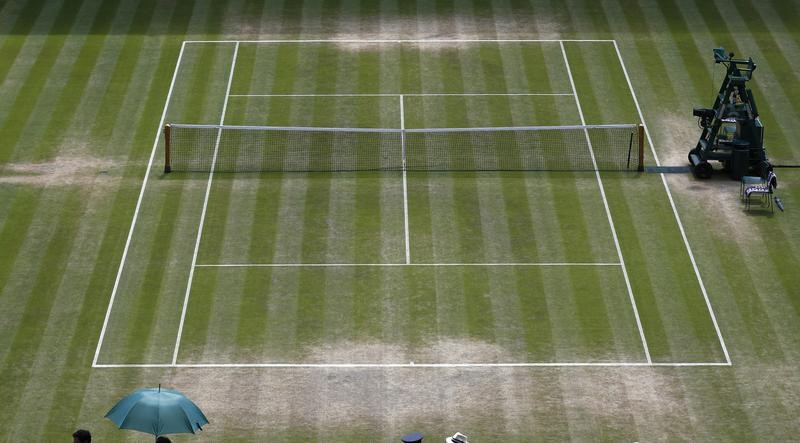By Simon Cambers
LONDON (Reuters) - At Wimbledon, where once players would charge the net almost on autopilot, the only time many get there now is when they shake hands at the end.
But for all the naysayers who say that changes to the grass itself has made it too easy for the baseliners, players at Wimbledon next month would do well to remember that attack still dominates and even serve and volley has its merits.
Tennis strategy analyst Craig O'Shannessy said 81 percent of all points in the men's singles at last year's Wimbledon (and 77 percent in the women's singles), were finished in the first five shots.
The Australian, an experienced coach who helped to mastermind Dustin Brown's victory over Rafael Nadal at Wimbledon in 2015, also looked at how players who win their matches perform in three categories; when the point was won in 1-4 shots, 5-8 shots or 9+.
"In 2016 at Wimbledon, for 0-4, the winning player won them 94 percent of the time," he told Reuters. For 5-8 it was 71 percent and in the 9+ category it was 64 percent.
"If you look at all four slams in 2016; for 0-4 it was 91 percent, for 5-8 it was 66 percent and for 9+, it was 55 percent. So the match winner, in the 9+ category is only just over 50-50."
Leading players admit that out and out attack is not necessarily the best strategy.
"You could just bludgeon back in the day and get high volleys," Bob Bryan, who together with his twin brother Mike Bryan has won 16 grand slam titles including three Wimbledons, told Reuters.
"Now you have to be more like a perfect pitcher. You've got to come and stick your volleys to the corners, or you're going to get passed. That's the bottom line."
But they will also tell you that attacking, aggressive tennis is still the best option.
"I think attack is well rewarded on grass," Milos Raonic, the runner-up to Andy Murray at Wimbledon last year. "Maybe it's a little bit less than before (but) I don't think it's necessarily because of the grass.
"I think it's more because of the athleticism of the players and preparation of the players and ability. Also with technology for the players to defend better. But there are very few guys that will say they are happy playing mostly defence on grass."
Sam Querrey, the American who upset Novak Djokovic as the defending champion at Wimbledon last year, agrees.
"You don't see guys serving and volleying as much, but you're still rewarded with a big serve and aggressive play," he said.
In response to criticism that the big-servers were making their showpiece into a boring ace contest, Wimbledon changed the grass it uses in late 2000 from 70 percent Rye and 30 percent creeping red fescue to 100 percent Rye.
The effect was obvious. In the 2002 men's final between Lleyton Hewitt and David Nalbandian, there was not a single serve-and-volley point, a far cry from the days of John McEnroe, Boris Becker and Pete Sampras.
The likes of Murray and Djokovic have made an art out of defending, their incredible movement and athleticism making it seem almost impossible to punch a hole through them.
Serve and volley is seen as a dying art, but O'Shannessy said the statistics show that it remains as effective as ever.
"There is absolutely no truth to the rumour or myth that serving and volleying doesn't work anymore," he told Reuters. "The win percentage remains the same whether you do it a lot or a little."
In 2002, an average of 33 percent of players in the men's singles served and volleyed, compared with just 8 percent in 2016. But in both years, players serving and volleying won the point 67 percent of the time.
"It just fell off the cliff, everybody stopped believing in it," O'Shannessy said. "The average stays almost identical whether you do it a little or you do it a lot. If you stay at the baseline (comparing 2002 with 2016) the win percentage stayed the same at 46 percent.
Are players simply being more selective in their use of it?
"In 2002, one out of three (33 percent) for an entire tournament is not being selective, it's a full-on charge, and you're still at 67 percent. In 2016, where you are being selective, it's identical at 67 percent. The selective guy and the all-out guy are winning the same percentage."
So why do players buy into the perception that longer rallies mean more success?
"Our minds trick us," O'Shannessy said. "We naturally remember the more spectacular, more fascinating, long rallies. You remember drama and there's very little drama in short rallies.
"Secondly, we have literally never had this data. We just haven't known how front-end-loaded winning is in a match.
"When we go to the practice court, we spend most of our time on the back end of the point, ball after ball after ball. We just got it wrong.

"The practice court is completely broken and doesn't mirror where winning happens in a match."